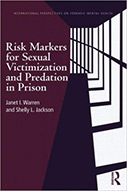Risk Markers for Sexual Victimization and Predation in Prison

Authors: Janet I, Warren and Shelly L. Jackson
Publisher: New York: Routledge, 2013. 356p.
Reviewer: Richard Tewksbury | November 2013
Sexual violence in correctional facilities has been a major policy and correctional practice concern for the last decade. Since the passage of the Prison Rape Elimination Act (PREA) in 2003, millions of dollars and untold numbers of hours have been devoted to studying, planning for, implementing and reviewing myriad issues related to “prison rape.” Warren and Jackson’s book represents one of the critical studies to emerge from PREA initiatives. Risk Markers for Sexual Victimization and Predation in Prison is the end product of one of the initial research grants funded by the National Institute of Justice for addressing PREA. The book is a testament to the advances that have come in both our knowledge about and means of studying sexual violence in corrections. However, this book also goes above and beyond, providing a litany of information both about sexual violence (as intended by PREA and the NIJ funding) and the sexual culture in correctional facilities more broadly.
Rather than limit their attention narrowly to “prison rape,” Warren and Jackson significantly advance understandings of prison sexuality by examining predatory sexual behavior, sexual victimization, and also two typically neglected (but seemingly more common) forms of sexual behavior among inmates – bartered sex and consensual sex. On all four fronts, Warren and Jackson provide a depth and breadth of information that has never been approached by previous scholars. Through a very detailed, carefully planned and well executed procedure data are drawn from both male and female inmates in Ohio and Texas, and used to examine demographic, childhood and adolescent experiences, community and institutional violence, sexual adaptation while incarcerated, emotional and perceptual states and personality measures, as correlates and predictors of all four types of targeted sexual behavior. The depth of the information available in this book is impressive. In some ways, because of the large amount of data and analyses that are presented, the book is more of a reference source that can be accessed for identifying correlates than it is a highly readable book. This is not meant as a criticism, but rather as a compliment to the scope of information presented in the 274 page volume. For all future scholars interested in studying sexual behavior in prison, this book should be their starting point.
Structurally the book contains 11 chapters, with eight chapters reporting the results of the study. Chapter 1 provides a well-structured, detailed, yet succinct overview of the political context preceding and leading up to the passage of PREA. This is integrated with an explanation of the need for and context in which the current study was planned and conducted. From this initial eleven page introduction the tone is set for a highly informative, nuanced understanding of prison sex and PREA issues. Chapter 2 is a detailed account of the study methods, sampling procedures, sample characteristics and instrumentation included in the study. It bears noting that a total of 16 standardized, clinical and risk assessment instruments were included in the questions to inmates – clearly Warren and Jackson were making sure to gather a wide range of information, and to be able to produce a study of both breadth and depth. In addition to the basics of the study presented in this chapter, so too there are four appendices that provide additional details on the samples and instrument coding. Chapter 2 and the accompanying appendices on their own would make for highly instructive reading for graduate students. But, the discussion of the study’s methods are not simple reporting of the who, what, how, when and where. In addition, there are interwoven discussions of the restrictions and challenges inherent in conducting research — especially sexual violence research — in prisons. For (especially younger) scholars looking for a model of how to report one’s methods completely, clearly, and yet in an interesting and engaging way, this is a great model.
Chapter 3 begins the reporting of the study’s findings. Here are reported the basic numbers about inmates’ participation in the four forms of sexual behavior under study, as well as high levels of correlation across the spectrum of sexual behaviors. Included in this chapter is a contextualization of the findings with the existing literature on prison sexuality. Such an approach is most prominent in this chapter, as the literature on prison sexuality is rather sparse and definitely not as specific in focus as the remaining chapters of this book. What the reader should come away with from this chapter is the idea that what may be the best way to identify potential predators and victims in the inmate population is to first identify inmates who are, in some way, sexually active.
Chapter 4 also builds on the existing literature and reports findings relating to early life abuse experiences and later in life risk behavior and victimization. Here the reader is shown how early in life adverse events are associated with sexual victimization while incarcerated, as well as with the predatory sexual abuse of other inmates. Sexual abuse early in life is especially linked with all forms of sexual activity while incarcerated for males, and for any sex and consensual sex for females. The findings in this chapter make a strong case for the consistency of sexual abuse and abusive behaviors over the life course, including for while one is in prison.
Chapter 5 assesses inmates’ past community and institutional violence as predictors of sexual behavior while incarcerated. Here the findings are somewhat surprising, as they show that neither sexual victimization nor sexual predation while in prison are associated with either having been in a physical fight outside of prison or any involvement in domestic violence. Also surprising is the conclusion that “most of the criminal history variables commonly used in prison classification schemes were unrelated to sexual behavior in prison among the male inmates” (p. 80). This sets up the presentation to come in chapter 9, where the general inability of existing risk instruments to predict sexual victimization is discussed.
Chapter 6, the shortest of the chapters reporting findings, focuses on assessing whether pre-prison sexual behaviors are associated with sexual behaviors while incarcerated. Again, perhaps surprising, and definitely supportive of a prisonization rather than importation model, there are very few relationships between sexual behavior prior to prison and while in prison for men. And, even more striking, for female inmates only the measure of a high rate of sexual activity prior to incarceration is correlated with consensual and predatory sexual behavior while incarcerated. Rather clearly, for men, their history of sexual behavior appears unrelated to their sexual behavior while in prison.
In Chapter 7, Warren and Jackson illustrate that most prison inmates, including both males and females, feel relatively safe in prison. Sexual assault is not something that every male inmate fears. In fact, the only fears that rise above a minimal level are male inmates’ concerns about physical attacks by staff. A sense of safety is common, despite perceptions that institutional staff persons are not especially interested in, nor capable of, ensuring inmates’ safety. The preponderance of a sense of safety is also juxtaposed with the fact that most inmates display high levels of impulsivity and at least occasional thoughts of harming others. Not surprisingly, male inmates who barter sex displayed more anger, fear and lower levels of perceived safety. Sexually victimized inmates were also more angry, fearful and less likely to endorse the ability of institutional staff to keep them safe. In sum, the affective and perceptual states of inmates “suggest that predatory, bartered, and consensual sex in prison for both genders is associated with impulsive behavior that to some extent predates incarceration and . . . is observed over many domains of a person’s life both in prison and in the community” (p. 135).
In Chapter 8, the high rates of diagnosable personality disorders among inmates is highlighted, with the especially high prevalence of antisocial personality disorder among male inmates and narcissistic personal disorder among female inmates seen as most influential on sexual behavior. Fitting with previous studies’ findings, the presence of a personality disorder is also seen as a significant risk factor for sexual victimization – “male inmates who were odd and eccentric in their behavior appear to be a higher risk for sexual victimization. Women who were anxious, unsure, and dependent in their relationships appear to be at higher risk for sexual victimization” (page 160). What the findings in this chapter do is both confirm, and further specify, a long indicated relationship between mental illness and sexual victimization in prison.
In Chapter 9 the focus shifts to assessing the predictive ability of established violence risk instruments to predict sexual victimization. The analyses offered suggest some, but not much correlation between risk instrument scores and sexual behaviors. In summarizing their results, Warren and Jackson conclude that sexual behavior in prison is associated with criminal and violent behavior in general, and that inmates most likely to be sexually active in prison are also involved in other violent behavior, both during and prior to incarceration.
Chapter 10 presents some fairly complex models linking the behaviors, traits and experiences identified throughout the study in CHAID (e.g. decision tree) models. These models are presented both for purposes of drawing together the myriad findings of the study and to suggest further lines of necessary study. Finally, Chapter 11 presents a summary of the findings, conclusions, and brief discussions of how the study findings fit with the context of the National Prison Rape Elimination Commission (and their developed standards for eliminating sexual violence in prisons and jails), and how prison policies regarding consensual sexual behavior in prison could (and should) be revised.
In total, Warren and Jackson have presented a weighty tome that is rich in detailed information, contextualized in regards to gender, criminal history, mental health status, pre-prison (including childhood) experiences, and affective state. The findings in this study go far beyond any prison sex research previously available, and hopefully can and will be seriously considered in the review and possible revisions of myriad institutional policies and practices. Any correctional practitioner who is committed to ensuring a safe, secure and humane incarceration experience for inmates should familiarize themselves with this book. There is a great deal of information here, and it may take more than one reading to digest all of the important aspects of the study findings; but the time, energy and resources that doing such would require would be a smart and valuable investment. For scholars seeking to design their own study of prison sex, or simply to ensure that their teaching and other research endeavors are well informed about the dynamics of prison sex, this book should be considered essential reading.
Dr. Richard Tewksbury is a Professor at the University of Louisville under the Department of A&S Justice Administration


